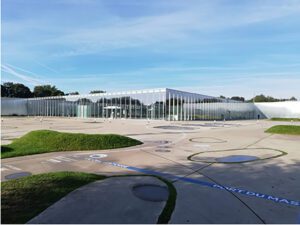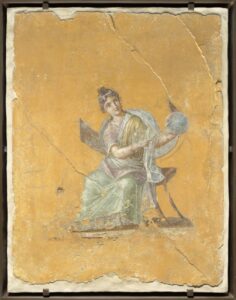The Louvre-Lens, France
Sam Vangheluwe

One advantage of living in a tiny country, is that you are within spitting distance from your neighbours. So, if workaday routine starts to become stifling, you merely have to shift a little – in any of the cardinal directions – and before you know it, the scenery has completely changed and a full dépaysement is afoot.
One of my favourite destinations is the north of France. It is only a couple of hours away (for me in Belgium) and 200 km from Paris (from the opposite direction), yet as soon as you cross the border, you know, you feel with all your senses that you’re in another country, where things are done differently.
Le Nord was once a flourishing industrialized region. The Great War and the WW II put an end to that. Even as a child, many decades later, I noticed the signs of depression: old buildings, old roads, old cars. Wonderful. In the 1970s, French automobile brands used inferior blue pigment to paint their cars. Due to ‘ultramarine disease’, the colors soon faded. Nowhere could you see more sallow lilac cars than in northern France. The color of decline.
Of course, things have long since changed. For decades, there has been a policy of decentralization, increasing autonomy of French municipalities and departments. Recently, in 2003, a plan was conceived to build a satellite of the Paris Louvre museum in Lens (Pas-de-Calais), of all places. It was hoped that this would reverse the fate of the depressed mining city of Lens.
Walking or driving through the streets of Lens (31,461 inhabitants), one is starkly reminded of its history. At the end of many a street, a humongous colliery waste heap looms up, like some otherworldly mountain. That, or part of the futuristic Lens soccer stadium. Most of the houses are former miners’ dwellings, built by the mining company. Unlike in Lille, or Roubaix, one sees hardly any historic signs of a once wealthy bourgeoisie. The centre of Lens is not very engaging – envisaged benefits of decentralization are hard to detect. As yet.
However, a short walk from downtown Lens is the Louvre-Lens, since 2012 nestled on a 49-acre mining site that was closed down in the 1960s. So this year is its tenth anniversary.
The architects (SANAA Kazuyo Sejima & Ryue Nishizawa, Tokyo + Imrey Culbert, New York), conceived the museum as a sprawling succession of five horizontal structures. You cannot see it from afar. The central square building has glass walls. The long walls of the others structures are of matte aluminum. The main reception area is in the square, central building. It houses several curved glass rooms that contain a cafeteria, media room and museum shop, a.o. At the entrance you pass through a security gate, manned by burly but polite middle-aged men. Ex-miners, I fancied (even though the last colliery closed in the 1980s). An X-ray machine might seem rather out of proportion, but then again, in 2013 someone (supposedly from/for “Architects & Engineers for 9/11 Truth”), vandalized Delacroix’ Liberty Leading the People with a black marker. I had no markers about my person, and was allowed in.
It takes some time to find your bearings among the circular glass structures of the reception area. At last I was directed to the reception desk. There, I found out that entrance was free: I had just missed the previous temporary exhibition Rome, and the coming one: Hieroglyphs. No matter.
The Galerie du Temps, to the east of the entry hall, houses about 200 items from the Paris Louvre collection, in an area of 3,000 m2 (32,000 sq ft). It is a huge, rectangular open hall, with the same aluminum walls as on the exterior, and natural lighting. The collection is simply arranged chronologically, from ca. 3,500 BC to the mid-19th century. As the works are loosely grouped according to cultural origin, the visitors instinctively weave through the exhibition, wend their way from one side to the other – and it doesn’t matter in what order. Every visitor weaves his/her personal thread through the warp of art history. At a stretch, one could grope one’s way along the left wall, straight to the end of the hall, and begin viewing the collection starting from the 19th century. Up to you.

Being in an amenable mood, and with mounting excitement, I started at the proposed beginning. Antiquity is represented by objects from Egypt, Persia, Mesopotamia, Assyria, Greece, Rome: the usual suspects. But interspersed (chronologically), you also encounter objects from pre-Columbian cultures. Not only does the configuration intimate the interaction between the great cultures, but it also allows a glimpse of what unconnected but coeval cultures were up to. Just check what era you’re in with the timeline high up on the right wall.
Antiquity flows seamlessly into Medieval art. I cannot remember having seen it so clearly: the cultural/artistic continuation – despite the (supposed) civilizational collapse or paradigm shift. The medieval section comprises not only Christian but also Muslim, and even (pre-)Columbian Mexican art. Early modern period: European, Islamic, Indian, Maori, Polynesian, African art.
The cultures of East and Southeast Asia are the ‘only’ ones missing. I don’t know why.
The summary above – I concede – may do little to arouse enthusiasm. Allow me to drop a few names in stead: meet Gudea, the Louvre Scribe, Gula, Astarte, Assurbanipal, Psamtik II, Pompey, Mithras, Alexander the Great, Jupiter, Marcus Aurelius, Theodosius II, the Virgin and Jesus, Huehueteotl, Anton Fugger, Louis XIV, Hendrickje Stoffels (yes!), Jean-Jacques Rousseau, Muhammad Shah Qajar, Cherubini, Napoleon Bonaparte.
That is without mentioning the countless objects that are ordinarily categorized as ‘utensils’, and the religious, devotional or ritual objects: earthenware, funerary sculpture, architectural fragments, images of unidentified divinities, mummies, metal work, lamps, jewelry, glass work, textiles, porcelain, and so on.
Maybe an effect of the visible remnants of proletarian Lens history, the art-historical tissue of the Galerie du temps presented itself to me as a history from God(s) to secularity, from religious to middle-class art. From works of art inhabited by gods, over art as validation of secular power, to art as identification of the bourgeoisie. An oversimplification, no doubt, but something to ponder. From a less ‘literary’ perspective, however, the Abbasid bowl, the Dogon statuette and Hendrickje Stoffels, to name but a few, are of course ever inhabited by an unknown god. Napoleon Bonaparte Crossing the Alps at the Pass of Grand-Saint Bernard, perhaps somewhat less so.
I heartily commend the chronological arrangement. It feels natural. It is straightforward, absorbing and engaging, and it does not, for once, involve the unsuspecting museum visitor choking on some far-fetched and imposed thematic order. It is genuinely gripping to look up from your chronological perusal and notice, for example, the prospect of an Egyptian faraonic statue, an Archaic kouros and a Roman copy of a Classical Greek discus thrower, all from one aspect – the warp of art history. Museums who champion thematic order often suggest that the chronological approach is outdated, scholarly, and therefore non-inclusive (i.e. elitist). I humbly suggest that this is bunk: you hardly need to be an academic to grasp chronological order. And in the myriad of materials, textures, shapes, dimensions, sensibilities, temperaments and embodiments, literally anyone can find some joy or wonderment. And you do so under your own steam.

©RMN-Grand Palais (musée du Louvre) Hervé Lewandowsk
The Louvre-Lens might not have the mass appeal of the Louvre-Paris, but if you eschew the masses, yet you wish your senses to be stirred, to be moved, your esthetic, historical, anthropological hunger to be satisfied, in a serene setting, I highly recommend more than one visit to the Louvre-Lens.
Oh, and the pâtisseries in the coffee shop are delectable.
